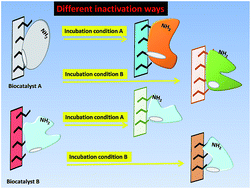Inactivation of immobilized trypsin under dissimilar conditions produces trypsin molecules with different structures†
Abstract
Bovine trypsin has been immobilized on glyoxyl-agarose and two different preparations have been produced. One was reduced just after immobilization, while the other was left to continue the enzyme-support reaction. This strategy is a guarantee of the identical orientation of the enzyme regarding the support surface and the identical physical properties of the support. Then, the two preparations were submitted to inactivations under different conditions: thermal and solvent inactivations under different pH values. After drying, the structures of the different enzymes preparations were analyzed by deconvolution of the amide I region, which provides information about the secondary structure of the protein in terms of α-helixes, β-sheets, β-turns and non-ordered or irregular structures. The results confirm that the structures of the different preparations were very different, suggesting that the inactivation ways were different for each enzyme preparation and dependent on the inactivation conditions. This information is very relevant for the design of strategies for enzyme stabilization, as shown by the fact that the inactivation may follow different conformational changes depending on the degree of enzyme rigidification and inactivation conditions.


 Please wait while we load your content...
Please wait while we load your content...